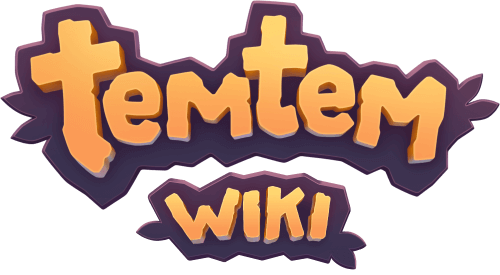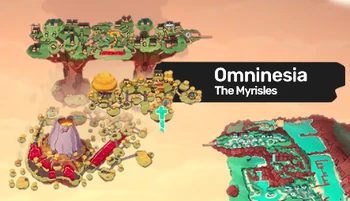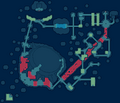Omninesia (”the Myrisles”) is a cluster of tropical islets connected by rope bridges, home of Nature and Fire Temtem. Enjoy the luxury of Atoll Row and investigate the lava caves of the Anak volcano. Omninesia consists of three islets - the Superior Omninesia, Citerior Omninesia, and the Ulterior Omninesia. The Citerior and Ulterior Omninesia can be accessed by Cableway.
| “ | Omninesian legends tell of a great volcanic eruption that shook the great Paninsula of old, breaking the mammoth island into smaller chunks and flinging them away. While Tucma and Kisiwa were the bigger ones, a scattering of smaller fragments drifted together. Their settlers called them the Myrisles, and during the foundation years they connected them with ingeniously built bridges, creating a whole new culture. The Omninesians, as they call themselves nowadays, are a reflection of that original spirit, endlessly resourceful and interested in communication and trade, always ready to make the most of their tiny but lush islands.
A prime example of this principle is The Lift, a contraption that communicates both halves of Omninesia. Except for occasional interruptions due to volcanic ash, airship traffic to Omninesia is regular and reliable. The Anak volcano is still semi-active, the one last remnant of that great primeval eruption. Within its depths, Fire Temtem abound, swimming in the lava pools. The jungles of the Flywalk are a great spot to catch Nature Temtem, and the twin towns of Mokupuni and Nanga both boast excellent dojos – which probably explains why the villas at Atoll Row are always full. |
„ |
| ~ Kickstarter Update #15 |
Interactive Map[]
This map shows locations for a number of different categories. it is possible to filter for wanted categories on the top left of the map window.
Please be aware that this map is work in progress.
| Filter explanation: |
| Activities: This category displays the location of special shops, repeatable activites and special features. Gears: Item locations which are found under the Gear tab in the inventory. |
Culture[]
The name "Omninesia" is an exonym. The citizens call their home "the Myrisles", which is the closest thing to its original pronunciation.![]() Nature Temtem and
Nature Temtem and ![]() Fire Temtem are ancestral Temtem of the island, and thus the traditional types for its citizens. For instance, Capyre appear commonly in folklore as tricksters. Its unreliable nature is embedded deeply in the culture. Omninesians also commonly give Raiber to novice trainers because its relatively mild-mannered nature for a Fire Temtem. Some Omninesians who branch out to tame Temtem of other types can experience minor backlash. However, other types have shaped its history as well. For instance, the first airships were built in the Myrisles, learning to navigate the thermals and winds by watching
Fire Temtem are ancestral Temtem of the island, and thus the traditional types for its citizens. For instance, Capyre appear commonly in folklore as tricksters. Its unreliable nature is embedded deeply in the culture. Omninesians also commonly give Raiber to novice trainers because its relatively mild-mannered nature for a Fire Temtem. Some Omninesians who branch out to tame Temtem of other types can experience minor backlash. However, other types have shaped its history as well. For instance, the first airships were built in the Myrisles, learning to navigate the thermals and winds by watching ![]() Wind Temtem, especially Saku and its ability to inflate air pockets within its body. Omninesia also has a long tradition of wind and percussion instruments, possibly influenced by its population of Wind types.
Wind Temtem, especially Saku and its ability to inflate air pockets within its body. Omninesia also has a long tradition of wind and percussion instruments, possibly influenced by its population of Wind types.
Omninesians pride themselves on their welcoming culture. "I see you" and "We share breath" are common Omninesian greetings. The later can also be used to mean "Welcome." "Out-Islander" is a common Omninesian way of referring to people who aren't native to the Myrisles, and, for short, out-islanders call people from the Myrisles "omni"--however, it is unclear if this nickname is derogatory. As a testament to their welcoming culture, the Myrisles Engineering Cooperative has opened its beds and working space to all travelers; once only open to its members, the Coop services foreigners for free. Because of this history, many foreigners, such as Kisiwans and Denizans, have settled in Nanga.
The Myrisles has two natural wonders which it reveres very honorably. The first, the volcano Anak, has always deeply shaped the people of the Myrisles. Anak, who "destroys and creates", is often either depicted as a female or with "it". Even today, it still erupts occasionally and creates new land for the people to build onto using their bridge-building skills. An initiation ritual in Omninesian tradition involves a pilgramage to Anak to recieve a blessing of the goddess and catch some wild ![]() Fire Temtem. It's possible a mythical Temtem named by legends "the Spirit of Anak" lives within the volcano.
Fire Temtem. It's possible a mythical Temtem named by legends "the Spirit of Anak" lives within the volcano.
The second natural wonder of the Myrisles is the Giant Banyan. The Banyan is a part of the great tree that sustains and nourishes the Myrisles. Although holy, it is also a common place, a sort of safe haven. It is welcome to everyone, belonging to everyone. In times of need, Omninesians have gathered there many times, but Temtem benefit from the tree as well. For instance, some use of its bark as a shield. The Banyan is filled with elusive Kinu, its spirit-guardian. They are a Temtem, and it is said a tamer doesn't catch Kinu; rather, they select who to be their tamer. They will know if the tamer is worthy, but they are very selective with their acquaintances. It is the guardian spirit of the Anak.
Omninesians create all kinds of foods and products from natural resources. Their traditional healing salve out of jungle roots, and the clothes of Mokupuni's The Flutes of Pansunset are natively made. The fruit-based production of Mokupuni results in kiwi, mango, papaya, kumquat, one of their main exports pomelos, and others.
Routes[]
Towns and Villages[]
Landmarks[]
Temtem[]
- Loali
- Paharac
- Hidody
- Banapi
- Babawa
- Kaku
- Saku
- Raiber
- Pewki
- Magmis
- Mastione
- Spriole
- Deendre
- Kinu
- Vulvir
- Vulor
- Koish
Dojos[]
Other[]
Trivia[]
- The inspiration of Omninesia are Oceanian island cultures. In particular, their central deity is based on the Hawaiian goddess Pele. Placenames and character names are derived from many Austronesian languages, including Tagalog, Hawaiian, Maori and Malagasy.
- Omninesia is the second playable island to be featured in the game, being one of two islands to explore in Alpha 2.
Gallery[]
Sources[]
| |||||||||||||||||||||||



